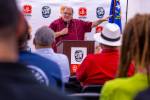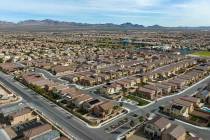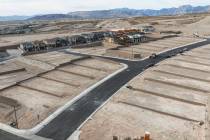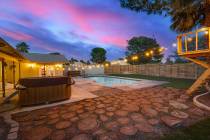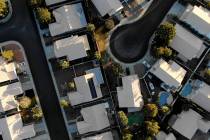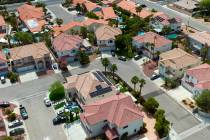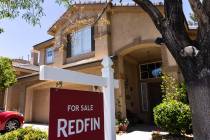New analysis shows foreclosures still plague parts of valley



Positively identified as the nation’s foreclosure capital, Las Vegas has lost more than 100,000 homes to the bank since January 2007, roughly 18 percent of the valley’s privately owned housing stock, housing analyst Larry Murphy of Las Vegas-based SalesTraq reported.
Sadly, Las Vegas is nowhere near finished with foreclosures, Murphy said.
In all likelihood, another 100,000 foreclosures are on the way, and at the current rate, that process will continue for another four to five years.
"It’s been really horrendous that 1 out of 5 homes are foreclosures and we’re not done yet," Murphy said. "By the time we get to 10 years, it could be half or 40 percent, and that’s staggering. It’s unbelievable."
Some areas have been hit harder than others, particularly those with newer subdivisions.
ZIP code 89086 shows 33 percent of homes, or 323, have gone through foreclosure, though the percentage is skewed by the small sampling of homes in a relatively new area of North Las Vegas, Murphy said.
The median home price there dropped from $298,949 in 2007 to $145,000 last year, SalesTraq reported. While it’s close to the northern Las Vegas Beltway and Interstate 15, the area may have been a little ahead of its time for new-home development.
The nearby master-planned Aliante community (89031) also faced a slowdown in new-home sales as Las Vegas got slammed by the subprime mortgage tsunami, which led to the foreclosure crisis and plummeting home prices. The foreclosure rate there is 23 percent, or 5,001 homes taken back by the bank.
A few miles to the west, Olympia Group went to foreclosure on 2,675 acres purchased at a Bureau of Land Management auction in 2005. Olympia had planned to develop the Park Highlands community.
Other ZIPs codes with high foreclosure rates — and scattered widely across the Las Vegas Valley — include 89081 (28 percent); 89139 (26 percent); and 89115, 89032 and 89143 (25 percent).
Murphy counted property addresses and the number of foreclosures in each Las Vegas Valley ZIP code to calculate his percentages. Any margin of error would lie in homes that may have been foreclosed twice in the nearly five-year period.
"This counts just homes that were foreclosed upon, not including short sales,” Murphy said. "One could make a case to include short sales because it’s very likely they would have gone to foreclosure. If you include short sales, it would be a solid 20 percent."
AT-RISK HOMEOWNERS
In another recent study, Prudential Americana Realtor Sam Wagmeister looked at homeowners who purchased during the boom years of 2004 to 2008 and were still occupying the same home.
His study was not as scientific as SalesTraq’s. It was a random selection of communities, ZIP codes and Multiple Listing Service areas from large tracts to 200-home subdivisions.
He found that most of the homes had been built since 1994 and shared common construction features such as stucco exteriors and tile roofs. Those homes are now valued at half their original purchase price and, based on current sales, represent five years of potential foreclosure inventory.
It will take at least that long for prices to turn up, Wagmeister figures.
"The assumption that I have is that, eventually, these homeowners will choose to stop supporting the superbanks by making payments on homes that they will probably never realize equity in, and either short-sell the properties or suffer the long-term consequences of foreclosure," Wagmeister said.
That’s more foreclosures coming down the pike. How many? That’s the big question everyone is asking, Murphy said.
Jacksonville, Fla.-based Lender Processing Services reported six months ago that 16 percent of Las Vegas homeowners with a mortgage were at least 30 days delinquent. After changing methodology to define delinquent as 30 to 90 days, the company revised the rate downward, to 10 percent. Noncurrent mortgages, defined as being more than 90 days late, were 17 percent.
Murphy figures that’s at least 27 percent of homeowners with notices of default, the first step in the foreclosure process.
"This is just an example of how confusing it is out there," he said. "The point is a lot of people are behind on their house payments. Whether it’s 10 percent or 17 percent or 27 percent, a lot of people are going into foreclosure."
Not that many in ZIP code 89134, which has the valley’s lowest foreclosure rate of 5 percent, or 674 homes.
Why? It’s predominantly Sun City Summerlin, where many retirees paid cash for their homes, Murphy said. The median price for a home in 89134 was $176,500 in 2010, compared with $294,117 in 2007, SalesTraq reported.
Las Vegas might have an even higher foreclosure rate if weren’t for the large population of retirees, many of whom do not have a mortgage and thus can’t be "underwater" on their homes. ZIP 89052, which includes Sun City Anthem, posted 12 percent foreclosures, or 2,427 homes.
Pulte Del Webb built age-restricted Sun City communities in Summerlin, MacDonald Ranch, Anthem and Aliante.
A new Nevada law requiring lenders to provide an affidavit of power to exercise foreclosure may slow them in the short term, but it won’t stop them, Murphy said.
Nevada was averaging about 4,000 notices of default a month through September. Default filings fell to 771 in October, when the law took effect, Discovery Bay, Calif.-based online listing service ForeclosureRadar reported.
"Some Realtors feel the world is coming to an end because the foreclosure process will take forever, while others feel it’s just a speed bump and things will be fine in a month or so," Tim Kelly Kiernan of Re/Max Extreme said about the Nevada law. "I met with my Bank of America contacts and they say it’s also just a speed bump. Who knows? Patience is a virtue, I guess."
James Saccacio, chief executive officer of Irvine, Calif.-based RealtyTrac, said the law helped cause a 75 percent drop in initial default notices in Nevada last month versus September, bringing defaults to the lowest level since the peak of the housing boom in June 2006.
"It’s like a rain delay," Saccacio said. "We’ll eventually see foreclosure processing go up."
Despite registering a 34 percent drop in foreclosure activity overall, Nevada still registered the highest foreclosure rate in the nation for October, with one in every 180 households receiving a foreclosure-related notice, RealtyTrac said.
In all, 230,678 U.S. homes received a foreclosure-related warning last month, up 7 percent from September, but down nearly 31 percent from October 2010.
Contact reporter Hubble Smith at hsmith@reviewjournal.com or 702-383-0491.






